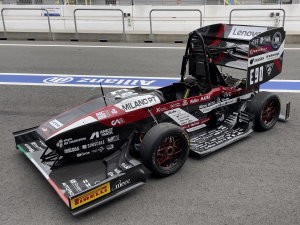Italy’s leading Student Racing team, Dynamis PRC and Vicor solve power and weight challenges in switch to Electric car protype

Dynamis PRC, the Formula Student team of Politecnico di Milano, has over 100 students and the team designs and manufactures a racing car prototype every year, for racing in the international Formula SAE championship. After 15 years in the combustion category, Dynamis PRC has reached fourth position, and first in Italy, in the Formula Student Combustion world ranking.
The team is now in the process of changing from a combustion engine to electric power, allowing it to make many improvements to the car’s design and performance. Chief among these was weight reduction, going from over 20kg for the original engine, to four 3.5kg electric motors, one mounted on each wheel. Each motor is independently controlled to optimise both traction and braking performance.
One of the major new components was the accumulator, which comprised 660 Sony VTC6 cells to deliver up to around 550V. To supply the vehicle’s 12V low voltage power, a LiFePO4 battery was also included in the electrical system. However, this was found to have very low autonomy. To solve this challenge, Dynamis decided to use the existing 12V circuit, powered by the low voltage battery, to supply the on-board PCBs, sensors, and telemetry equipment.
Dynamis would then step down the voltage from the high voltage accumulator and extract 12V, using two DC-DC converter modules. This method would be used to meet the more demanding part of the low-voltage load, sourcing 600W – 50A at 12V – to supply the cooling fans and cooling water pump.
After an extended search for suitable DC-DC products, Dynamis settled on Vicor’s DCM4623 module, as it satisfied all their system requirements. The Vicor DC-DC converter module can operate in array mode, accommodating an input supply from the accumulator that ranged from 550V down to 330V as the batteries discharged during a race.
For more information see the original Press Release.




